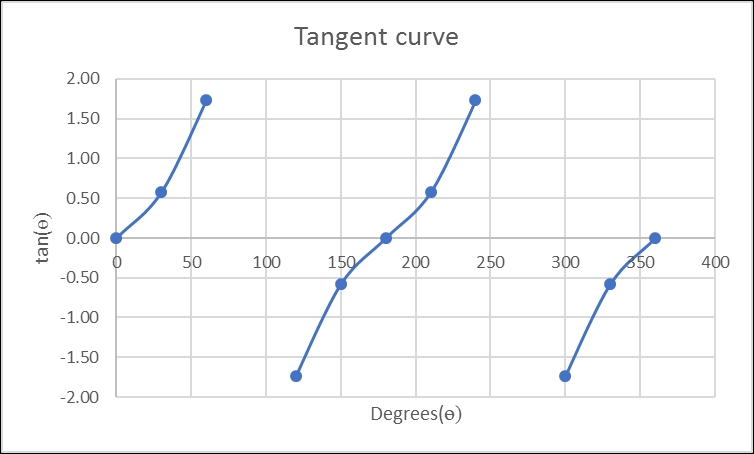Since tan(x) = sine(x)/cosine(x), we could combine the Taylor series formula of the sine(x) and cos(x) to construct the tangent function as follows:

Write, compile, and run this Serial tangent(x) code (see the following serial tangent(x) code) to get a feel of the program:
/**********************************
* Serial tangent(x) code. *
* *
* Taylor series representation *
* of the trigonometric tan(x). *
* *
* Author: Carlos R. Morrison *
* *
* Date: 1/10/2017 *
**********************************/
#include <math.h>
#include <stdio.h>
int main(void)
{
/************************************************/
unsigned int i,j,l;
unsigned long int k;
long long int B,D,G,I;
int num_loops = 17;
float y;
double x;
double sum=0,sum01=0,sum02=0;
double A,C,E,F,H,J;
/************************************************/
/************************************************/
printf("
");
Z:printf("Enter angle(deg.):
");
printf("
");
scanf("%f",&y);
if(y >= 0 && y < 90.0)
{
x = y*(M_PI/180.0);
}
else
if(y > 90.0 && y <= 180.0)
{
x = -(180.0-y)*(M_PI/180.0);
}
else
if(y >= 180.0 && y < 270)
{
x = -(180-y)*(M_PI/180.0);
}
else
if(y > 270.0 && y <= 360)
{
x = -(360.0-y)*(M_PI/180.0);
}
else
{
printf("
");
printf("Bad input!! Please try another angel
");
printf("
");
goto Z;
}
/*************************************************
* ***** SINE BLOCK ***** *
*************************************************/
sum01 = 0;
for(i = 0; i < num_loops; i++)
{
A = (double)pow(-1,i);
B = 2*i+1;
C = (double)pow(x,B);
D = 1;
for(j = 1; j <= B; j++)
{
D *= j;
}
E = (A*C)/(double)D;
sum01 += E;
}// End of for(i = 0; i < num_loops; i++)
/*****************************************************
* ***** COSINE BLOCK ***** *
*****************************************************/
sum02 = 0;
for(k = 0; k < num_loops; k++)
{
F = (double)pow(-1,k);
G = 2*k;
H = (double)pow(x,G);
I = 1;
for(l = 1; l <= G; l++)
{
I *= l;
}
J = (F*H)/(double)I;
sum02 += J;
}// End of for(k = 0; k < num_loops; k++)
/*****************************************************
* ***** TANGENT BLOCK ***** *
*****************************************************/
/*******************/
sum = sum01/sum02; // Tan(x) ==> Sine(x)/Cos(x)
/*******************/
/*****************************************************/
printf("
");
printf("%.1f deg. = %.3f rads
", y, x);
printf("Tan(%.1f) = %.3f
", y, sum);
return 0;
}
Next, write, compile, and run the MPI version of the preceding serial tan(x) code (see MPI tan(x) code below), using one processor from each of the 16 nodes.
/**********************************
* MPI tangent(x) code. *
* *
* Taylor series representation *
* of the trigonometric tan(x). *
* *
* Author: Carlos R. Morrison *
* *
* Date: 1/10/2017 *
**********************************/
#include <mpi.h> // (Open)MPI library
#include <math.h> // math library
#include <stdio.h>// Standard Input/Output library
int main(int argc, char*argv[])
{
/******************************************************************************/
unsigned int i,j,l;
unsigned long int k,m,n;
long long int B,D,G,I;
int Q = 17,rank,length,numprocs;
float x,y;
double sum,sum1,sum2,sum01=0,sum02=0,rank_sum,rank_sum1,rank_sum2;
double A,C,E,F,H,J;
char hostname[MPI_MAX_PROCESSOR_NAME];
MPI_Init(&argc, &argv); // initiates MPI
MPI_Comm_size(MPI_COMM_WORLD, &numprocs); // acquire number of processes
MPI_Comm_rank(MPI_COMM_WORLD, &rank); // acquire current process id
MPI_Get_processor_name(hostname, &length); // acquire hostname
/******************************************************************************/
if(rank == 0)
{
printf("
");
printf("#######################################################");
printf("
");
printf("*** Number of processes: %d
",numprocs);
printf("*** processing capacity: %.1f GHz.
",numprocs*1.2);
printf("
");
printf("Master node name: %s
", hostname);
printf("
");
printf("
");
Z: printf("Enter angle(deg.):
");
printf("
");
scanf("%f",&y);
if(y >= 0 && y < 90.0)
{
x = y*(M_PI/180.0);
}
else
if(y > 90.0 && y <= 180.0)
{
x = -(180.0-y)*(M_PI/180.0);
}
else
if(y >= 180.0 && y < 270)
{
x = -(180-y)*(M_PI/180.0);
}
else
if(y > 270.0 && y <= 360)
{
x = -(360.0-y)*(M_PI/180.0);
}
else
{
printf("
");
printf("Bad input!! Please try another angel
");
printf("
");
goto Z;
}
}// End of if(rank == 0)
/******************************************************************************/
//broadcast to all processes, the number of segments you want
MPI_Bcast(&Q, 1, MPI_INT, 0, MPI_COMM_WORLD);
MPI_Bcast(&x, 1, MPI_INT, 0, MPI_COMM_WORLD);
// this loop increments the maximum number of iterations, thus providing
// additional work for testing computational speed of the processors
//for(total_iter = 1; total_iter < Q; total_iter++)
{
sum01 = 0;
sum02 = 0;
// for(total_iter = 1; i < total_iter; total_iter++)
for(i = rank + 1; i <= Q; i += numprocs)
{
m = (i-1);
/*************************************************
* ***** SINE BLOCK ***** *
*************************************************/
A = (double)pow(-1,m);
B = 2*m+1;
C = (double)pow(x,B);
D = 1;
for(j = 1; j <= B; j++)
{
D *= j;
}
E = (A*C)/(double)D;
sum01 += E;
/*****************************************************
* ***** COSINE BLOCK ***** *
*****************************************************/
F = (double)pow(-1,m);
G = 2*m;
H = (double)pow(x,G);
I = 1;
for(l = 1; l <= G; l++)
{
I *= l;
}
J = (F*H)/(double)I;
sum02 += J;
}// End of for(i = rank + 1; i <= Q; i += numprocs)
rank_sum1 = sum01;
rank_sum2 = sum02;
//collect and add the partial sum0 values from all processes
MPI_Reduce(&rank_sum1, &sum1, 1, MPI_DOUBLE,MPI_SUM, 0, MPI_COMM_WORLD);
MPI_Reduce(&rank_sum2, &sum2, 1, MPI_DOUBLE,MPI_SUM, 0, MPI_COMM_WORLD);
}//End of for(total_iter = 1; total_iter < n; total_iter++)
if(rank == 0)
{
sum = sum1/sum2;// Tan(x) ==> Sine(x)/Cos(x)
printf("
");
printf("%.1f deg. = %.3f rads
", y, x);
printf("Tan(%.1f) = %.3f
", y, sum);
}
// clean up, done with MPI
MPI_Finalize();
return 0;
}// End of int main(int argc, char*argv[])
Now, we will check the MPI tan(x) run:
alpha@Mst0:/beta/gamma $ time mpiexec -H Mst0,Slv1,Slv2,Slv3,Slv4,Slv5,Slv6,Slv7,Slv8, Slv9,Slv10,Slv11,Slv12,Slv13,Slv14,Slv15 MPI_tan ####################################################### *** Number of processes: 16 *** processing capacity: 19.2 GHz. Master node name: Mst0 Enter angle(deg.): 0 0.0 deg. = 0.000 rads Tan(0.0) = 0.000 real 0m19.636s user 0m1.180s sys 0m0.430s alpha@Mst0:/beta/gamma $ time mpiexec -H Mst0,Slv1,Slv2,Slv3,Slv4,Slv5,Slv6,Slv7,Slv8, Slv9,Slv10,Slv11,Slv12,Slv13,Slv14,Slv15 MPI_tan ####################################################### *** Number of processes: 16 *** processing capacity: 19.2 GHz. Master node name: Mst0 Enter angle(deg.): 30 30.0 deg. = 0.524 rads Tan(30.0) = 0.577 real 0m13.139s user 0m1.360s sys 0m0.260s alpha@Mst0:/beta/gamma $ time mpiexec -H Mst0,Slv1,Slv2,Slv3,Slv4,Slv5,Slv6,Slv7,Slv8, Slv9,Slv10,Slv11,Slv12,Slv13,Slv14,Slv15 MPI_tan ####################################################### *** Number of processes: 16 *** processing capacity: 19.2 GHz. Master node name: Mst0 Enter angle(deg.): 60 60.0 deg. = 1.047 rads Tan(60.0) = 1.732 real 0m7.451s user 0m1.250s sys 0m0.330s alpha@Mst0:/beta/gamma $ time mpiexec -H Mst0,Slv1,Slv2,Slv3,Slv4,Slv5,Slv6,Slv7,Slv8, Slv9,Slv10,Slv11,Slv12,Slv13,Slv14,Slv15 MPI_tan ####################################################### *** Number of processes: 16 *** processing capacity: 19.2 GHz. Master node name: Mst0 Enter angle(deg.): 90 Bad input!! Please try another angel Enter angle(deg.): 120 120.0 deg. = -1.047 rads Tan(120.0) = -1.732 real 0m17.420s user 0m1.210s sys 0m0.360s alpha@Mst0:/beta/gamma $ time mpiexec -H Mst0,Slv1,Slv2,Slv3,Slv4,Slv5,Slv6,Slv7,Slv8, Slv9,Slv10,Slv11,Slv12,Slv13,Slv14,Slv15 MPI_tan ####################################################### *** Number of processes: 16 *** processing capacity: 19.2 GHz. Master node name: Mst0 Enter angle(deg.): 150 150.0 deg. = -0.524 rads Tan(150.0) = -0.577 real 0m11.704s user 0m1.410s sys 0m0.370s alpha@Mst0:/beta/gamma $ time mpiexec -H Mst0,Slv1,Slv2,Slv3,Slv4,Slv5,Slv6,Slv7,Slv8, Slv9,Slv10,Slv11,Slv12,Slv13,Slv14,Slv15 MPI_tan ####################################################### *** Number of processes: 16 *** processing capacity: 19.2 GHz. Master node name: Mst0 Enter angle(deg.): 180 180.0 deg. = -0.000 rads Tan(180.0) = 0.000 real 0m5.871s user 0m1.190s sys 0m0.370s alpha@Mst0:/beta/gamma $ time mpiexec -H Mst0,Slv1,Slv2,Slv3,Slv4,Slv5,Slv6,Slv7,Slv8, Slv9,Slv10,Slv11,Slv12,Slv13,Slv14,Slv15 MPI_tan ####################################################### *** Number of processes: 16 *** processing capacity: 19.2 GHz. Master node name: Mst0 Enter angle(deg.): 210 210.0 deg. = 0.524 rads Tan(210.0) = 0.577 real 1m8.558s user 0m1.190s sys 0m0.550s alpha@Mst0:/beta/gamma $ time mpiexec -H Mst0,Slv1,Slv2,Slv3,Slv4,Slv5,Slv6,Slv7,Slv8, Slv9,Slv10,Slv11,Slv12,Slv13,Slv14,Slv15 MPI_tan ####################################################### *** Number of processes: 16 *** processing capacity: 19.2 GHz. Master node name: Mst0 Enter angle(deg.): 240 240.0 deg. = 1.047 rads Tan(240.0) = 1.732 real 0m22.489s user 0m1.310s sys 0m0.270s alpha@Mst0:/beta/gamma $ time mpiexec -H Mst0,Slv1,Slv2,Slv3,Slv4,Slv5,Slv6,Slv7,Slv8, Slv9,Slv10,Slv11,Slv12,Slv13,Slv14,Slv15 MPI_tan ####################################################### *** Number of processes: 16 *** processing capacity: 19.2 GHz. Master node name: Mst0 Enter angle(deg.): 270 Bad input!! Please try another angel Enter angle(deg.): 300 300.0 deg. = -1.047 rads Tan(300.0) = -1.732 real 0m15.178s user 0m1.180s sys 0m0.410s alpha@Mst0:/beta/gamma $ time mpiexec -H Mst0,Slv1,Slv2,Slv3,Slv4,Slv5,Slv6,Slv7,Slv8, Slv9,Slv10,Slv11,Slv12,Slv13,Slv14,Slv15 MPI_tan ####################################################### *** Number of processes: 16 *** processing capacity: 19.2 GHz. Master node name: Mst0 Enter angle(deg.): 330 330.0 deg. = -0.524 rads Tan(330.0) = -0.577 real 0m7.067s user 0m1.200s sys 0m0.370s alpha@Mst0:/beta/gamma $ time mpiexec -H Mst0,Slv1,Slv2,Slv3,Slv4,Slv5,Slv6,Slv7,Slv8, Slv9,Slv10,Slv11,Slv12,Slv13,Slv14,Slv15 MPI_tan ####################################################### *** Number of processes: 16 *** processing capacity: 19.2 GHz. Master node name: Mst0 Enter angle(deg.): 360 360.0 deg. = -0.000 rads Tan(360.0) = 0.000 real 0m6.489s user 0m1.200s sys 0m0.340s
The following figure is a plot of the MPI tan(x) run:

..................Content has been hidden....................
You can't read the all page of ebook, please click here login for view all page.
